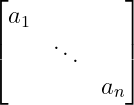Latex diagonal dots are the sum of three dots located along the diagonal. This diagonal dots symbol is represented by the \ddots command.
| Properties | Value |
| Symbol | Diagonal dots |
| Package | Default |
| Command | \ddots |
| Argument | No |
| Example | \ddots → |
These diagonal dots are used to represent a matrix with n number of elements.
\documentclass{article}
\begin{document}
\[ \ddots \]
\end{document}Output :
And you see the diagonal matrix where the elements of the matrix are arranged just along the diagonal. In that case, only the latex diagonal dots symbol is used.
\documentclass{article}
\usepackage{amsmath}
\begin{document}
\[ \begin{bmatrix}
a_{1} & & \\
& \ddots & \\
& & a_{n}
\end{bmatrix}\]
\end{document}Output :
Inverse diagonal dots
Inverse diagonal dots are located in a diagonal direction from southwest to northeast.
Latex has more than one command and method to represent this inverse diagonal dots symbol.
| Package | command |
| MySymbol | \udots |
| Mathdots | \iddots |
| yhmath | \adots |
| graphicx | \reflectbox{...} |
\documentclass{article}
\usepackage{graphicx}
\usepackage{yhmath}
\usepackage{mathdots}
\usepackage{MnSymbol}
\begin{document}
\[ \iddots \]
\[ \udots \]
\[ \adots \]
\[ \reflectbox{$\ddots$} \]
\end{document}Output :
$\ddots$ is passed as an argument in \reflectbox command which converts diagonal dots symbol to inverse diagonal dots symbol. And for this, you need to take the help of graphicx package.
